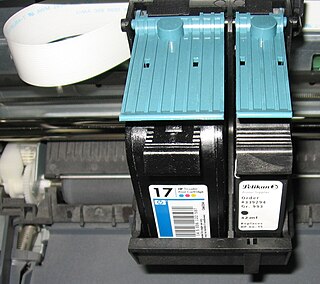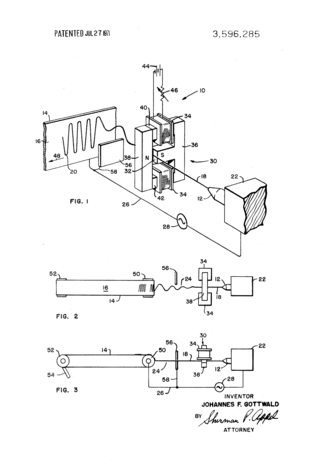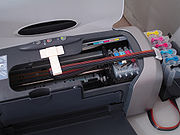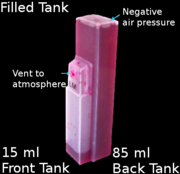
In the field of computing, a printer is considered a peripheral device that serves the purpose of creating a permanent representation of text or graphics, usually on paper. While the majority of outputs produced by printers are readable by humans, there are instances where barcode printers have found a utility beyond this traditional use. Different types of printers are available for use, including inkjet printers, thermal printers, laser printers, and 3D printers.

Laser printing is an electrostatic digital printing process. It produces high-quality text and graphics by repeatedly passing a laser beam back and forth over a negatively charged cylinder called a "drum" to define a differentially charged image. The drum then selectively collects electrically charged powdered ink (toner), and transfers the image to paper, which is then heated to permanently fuse the text, imagery, or both, to the paper. As with digital photocopiers, laser printers employ a xerographic printing process. Laser printing differs from traditional xerography as implemented in analog photocopiers in that in the latter, the image is formed by reflecting light off an existing document onto the exposed drum.

Dot matrix printing, sometimes called impact matrix printing, is a computer printing process in which ink is applied to a surface using a relatively low-resolution dot matrix for layout. Dot matrix printers are a type of impact printer that prints using a fixed number of pins or wires and typically use a print head that moves back and forth or in an up-and-down motion on the page and prints by impact, striking an ink-soaked cloth ribbon against the paper. They were also known as serial dot matrix printers. Unlike typewriters or line printers that use a similar print mechanism, a dot matrix printer can print arbitrary patterns and not just specific characters.

Inkjet printing is a type of computer printing that recreates a digital image by propelling droplets of ink onto paper and plastic substrates. Inkjet printers were the most commonly used type of printer in 2008, and range from small inexpensive consumer models to expensive professional machines. By 2019, laser printers outsold inkjet printers by nearly a 2:1 ratio, 9.6% vs 5.1% of all computer peripherals.

Dye-sublimation printing is a term that covers several distinct digital computer printing techniques that involve using heat to transfer dye onto a substrate.

Seiko Epson Corporation, commonly known as Epson, is a Japanese multinational electronics company and one of the world's largest manufacturers of printers and information- and imaging-related equipment. Headquartered in Suwa, Nagano, Japan, the company has numerous subsidiaries worldwide and manufactures inkjet, dot matrix, thermal and laser printers for consumer, business and industrial use, scanners, laptop and desktop computers, video projectors, watches, point of sale systems, robots and industrial automation equipment, semiconductor devices, crystal oscillators, sensing systems and other associated electronic components.
Gutenprint is a collection of free-software printer drivers for use with UNIX spooling systems, such as CUPS, LPR, and LPRng. These drivers provide printing services for Unix-like systems, RISC OS and Haiku.
An Iris printer is a large-format color inkjet printer designed for prepress proofing. It was introduced in 1985 by Iris Graphics, originally of Stoneham, Massachusetts, and is currently manufactured by the Graphic Communications Group of Eastman Kodak. It is also used in the fine art reproduction market as a final output digital printing press, as in Giclée.

Kodak EasyShare was a sub-brand of Eastman Kodak Company products identifying a consumer photography system of digital cameras, snapshot thermal printers, snapshot thermal printer docks, all-in-one inkjet printers, accessories, camera docks, software, and online print services. The brand was introduced in 2001, and discontinued in 2012, when Kodak stopped manufacturing and selling all digital cameras and photo frames.

An ink cartridge or inkjet cartridge is the component of an inkjet printer that contains the ink to be deposited onto paper during printing. It consists of one or more ink reservoirs and can include electronic contacts and a chip to exchange information with the printer.
In economic literature, the term "aftermarket" refers to a secondary market for the goods and services that are 1) complementary or 2) related to its primary market goods. In many industries, the primary market consists of durable goods, whereas the aftermarket consists of consumable or non-durable products or services.

Inkjet paper is a special fine paper designed for inkjet printers, typically classified by its weight, brightness and smoothness, and sometimes by its opacity.

Solid ink is a type of ink used in printing. Solid ink is a waxy, resin-based polymer that must be melted prior to usage, unlike conventional liquid inks. The technology is used most often in graphics and large-format printing environments where color vividness and cost efficiency are important.
Compatible ink is manufactured by third-party manufacturers and is designed to work in designated printers without infringing on patents of printer manufacturers. Compatible inks and toners may come in a variety of packaging including sealed plastic wraps or taped plastic wraps. Regardless of packaging, compatible products are generally priced lower than original equipment manufacturer (OEM) brand inks and toners.
Dynamic Cassette International (DCI) is an internationally recognised Boston, Lincolnshire, UK based ink cartridge and laser toner manufacturing company, producing products under the Jet Tec brand name. DCI is the sole UK manufacturer of compatible ink cartridges. DCI is notable for winning the Queen's Award for Enterprise: Innovation in 2004 and the Queen's Award for Export and being one of the biggest employers in Boston, employing over 300 staff at its 40,000 square metres factory. The company is currently Europe's largest manufacturer of compatible inkjet cartridges and has a turnover in excess of £20 million.

A toner cartridge, also called laser toner, is the consumable component of a laser printer. Toner cartridges contain toner powder, a fine, dry mixture of plastic particles, carbon, and black or other coloring agents that make the actual image on the paper. The toner is transferred to paper via an electrostatically charged drum unit, and fused onto the paper by heated rollers during the printing process. It will not stain like ink cartridges, but it can get messy if handled improperly.

Tonejet is a drop-on-demand inkjet printing technology that enables the direct digital deposition of printing ink onto substrates. The Tonejet digital printing process is targeted at commercial and industrial applications.

The RemaxWorld Expo is an annual trade show comprising vendors from within the print consumables industry. The event began in 2007, resulting from a joint venture between the China Council for the Promotion of International Trade (CCPIT) and Recycling Times Media Corporation. Centered in Zhuhai, widely recognized as being the print consumables capital of the world, the exhibition currently takes place in the newly constructed Zhuhai International Convention & Exhibition Center. In 2015, the show accommodated 463 exhibitors and 13,938 visitors from 83 countries.

Inkjet technology originally was invented for depositing aqueous inks on paper in 'selective' positions based on the ink properties only. Inkjet nozzles and inks were designed together and the inkjet performance was based on a design. It was used as a data recorder in the early 1950s, later in the 1950s co-solvent-based inks in the publishing industry were seen for text and images, then solvent-based inks appeared in industrial marking on specialized surfaces and in the1990's phase change or hot-melt ink has become a popular with images and digital fabrication of electronic and mechanical devices, especially jewelry. Although the terms "jetting", "inkjet technology" and "inkjet printing", are commonly used interchangeably, inkjet printing usually refers to the publishing industry, used for printing graphical content, while industrial jetting usually refers to general purpose fabrication via material particle deposition.
Supertank printers are a type of continuous ink system (CISS) inkjet printer. Supertank printers differ from traditional inkjet printers in that the printhead is connected via a tube system that draws ink from large ink tanks built into the printer, which are filled and refilled via ink bottles, eliminating the need for ink cartridges. Cost-per-page (CPP) is significantly lower than traditional cartridges, as replacement ink bottles contain enough ink to print thousands of pages, and typically cost under $20.




















